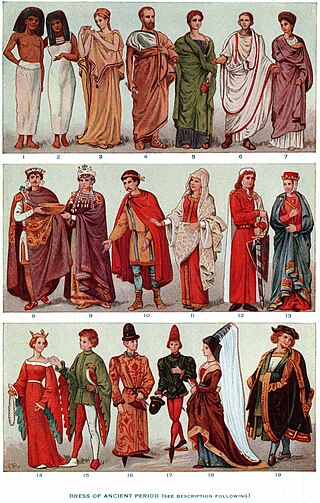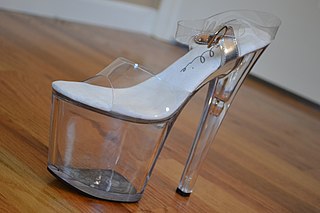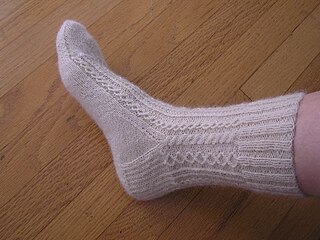
Wearing socks and sandals together is a controversial fashion combination and social phenomenon that is discussed in various countries and cultures. In some places it is considered a fashion faux pas. [1]

Wearing socks and sandals together is a controversial fashion combination and social phenomenon that is discussed in various countries and cultures. In some places it is considered a fashion faux pas. [1]

The earliest evidence of wearing socks and sandals is documented at the archaeological site between Dishforth and Leeming in North Yorkshire, England. The discovery suggests that ancient Romans wore socks with sandals at least 2,000 years ago. [2] [3]
Tabi are a type of traditional Japanese socks designed to be worn together with sandals that have been used since at least the 15th century. [4]
Saurabh Bhatia, the author of the book Indian Corporate Etiquette, advises readers: "If, for some reason, you are not wearing socks with sandals, ensure your toes are clean and your toe-nails are closely clipped". [5] Joshua Belter, the author of The Book of Rules: The Right Way to Do Everything, points out that wearing socks with sandals reduces the amount of cooling feet experience. [6] However, energy design handbooks include light socks and sandals as part of a high-thermal flux tropical attire. [7] [8]
According to Brian Shea of The Evening Sun, wearing socks and sandals is popular among the older generation and Germans. [9]
The Britons are, according to The China Post , "famed for fashion blunders like wearing socks with sandals". [10]
Wearing socks and sandals is considered rather unaesthetic in the Czech Republic; however, some people prefer socks and sandals, and a part of the population prefers both the options (sandals with and without socks). [11]
In Israel, socks and sandals are stereotypically associated with immigrants from the former Soviet Union. [12] [13] [14]
Socks and sandals is a regular Pacific Northwest phenomenon. [15] [16] [17] Seattle based insurance company PEMCO used the "Sandals & Socks Guy" character as part of a 2007 advertising campaign that portrayed this as a typically Pacific Northwest fashion. [18] [19] The Daily Dot highlighted "sandals and socks" as a term entered into a web search engine more often by Washingtonians than residents of any other state. [20]

Wearing socks and sandals is associated by some with geek culture. [21] [22] Socks and sandals were noted as a "high crime of fashion" when introduced as Xbox Live avatar accessory downloadable content in 2009. [23]
In 2010, the newspaper Daily Telegraph reported that wearing socks and sandals was a hit for spring/summer of that year. [24] Starting in 2010, and again in 2014, several sources reported that socks and sandals had become a fashion trend in the United States and the United Kingdom, appearing in several runway shows, including those of Miu Miu (2010) and fashion designers Vivienne Tam and Mary-Kate and Ashley Olsen (2014), and picked up by celebrities. [25] [26] [27] [28] [29] [30]

Clothing is any item worn on the body. Typically, clothing is made of fabrics or textiles, but over time it has included garments made from animal skin and other thin sheets of materials and natural products found in the environment, put together. The wearing of clothing is mostly restricted to human beings and is a feature of all human societies. The amount and type of clothing worn depends on gender, body type, social factors, and geographic considerations. Garments cover the body, footwear covers the feet, gloves cover the hands, while hats and headgear cover the head, and underwear covers the private parts.

Footwear refers to garments worn on the feet, which typically serve the purpose of protection against adversities of the environment such as wear from rough ground; stability on slippery ground; and temperature.

Stockings are close-fitting, variously elastic garments covering the leg from the foot up to the knee or possibly part or all of the thigh. Stockings vary in color, design, and transparency. Today, stockings are primarily worn for fashion and aesthetics, usually in association with mid-length or short skirts.

Colloquially, room temperature is a range of air temperatures that most people prefer for indoor settings. These temperatures feel comfortable to people wearing typical indoor clothing. Human comfort can extend beyond this range depending on humidity, air circulation and other factors.

Tabi are traditional Japanese socks worn with thonged footwear such as zori, dating back to the 15th century.

Clogs are a type of footwear made in part or completely from wood. Used in many parts of the world, their forms can vary by culture, but often remained unchanged for centuries within a culture.

Flip-flops are a type of light sandal-like shoe, typically worn as a form of casual footwear. They consist of a flat sole held loosely on the foot by a Y-shaped strap known as a toe thong that passes between the first and second toes and around both sides of the foot. This style of footwear has been worn by people of many cultures throughout the world, originating as early as the ancient Egyptians in 1500 BC. In the United States the modern flip-flop may have had its design taken from the traditional Japanese zōri, after World War II as soldiers brought them back from Japan.

A hat is a head covering which is worn for various reasons, including protection against weather conditions, ceremonial reasons such as university graduation, religious reasons, safety, or as a fashion accessory. Hats which incorporate mechanical features, such as visors, spikes, flaps, braces or beer holders shade into the broader category of headgear.

Geta (下駄) are traditional Japanese footwear resembling flip-flops. A kind of sandal, geta have a flat wooden base elevated with up to three "teeth", held on the foot with a fabric thong, which keeps the foot raised above the ground.

Platform shoes are shoes, boots, or sandals with a thick sole, usually in the range of 3–10 cm (1–4 in). Platform shoes may also be high heels, in which case the heel is raised significantly higher than the ball of the foot. Extreme heights, of both the sole and heel, can be found in fetish footwear such as ballet boots, where the sole may be up to 20 cm (8 in) high and the heels up to 40 cm (16 in) or more. The sole of a platform shoe can have a continuous uniform thickness, have a wedge, a separate block or a stiletto heel. Raising the ankle increases the risk of a sprained ankle.

Sandals are an open type of shoe, consisting of a sole held to the wearer's foot by straps going over the instep and around the ankle. Sandals can also have a heel. While the distinction between sandals and other types of footwear can sometimes be blurry, the common understanding is that a sandal leaves all or most of the foot exposed. People may choose to wear sandals for several reasons, among them comfort in warm weather, economy, and as a fashion choice. Usually, people wear sandals in warmer climates or during warmer parts of the year in order to keep their feet cool and dry. The risk of developing athlete's foot is lower than with enclosed shoes, and the wearing of sandals may be part of the treatment regimen for such an infection.

Leggings are several types of leg attire that have varied through the years. Modern usage from the 1960s onwards has come to refer to elastic close-fitting high-rise garments worn over the legs typically by women, such as leg warmers or tights. Usage from the 18th century refers to men's wear usually made of cloth or leather that is wrapped around the leg down to the ankle. In the 19th century, leggings usually referred to infants' leg clothing that were matched with a jacket, as well as leg-wrappings made of leather or wool and worn by soldiers and trappers. Leggings prominently returned to women's fashion in the 1960s, drawing from the form-fitting clothing of dancers. With the widespread adoption of the synthetic fibre Lycra and the rise in popularity of aerobics, leggings came to further prominence in the 1970s and 1980s, and eventually made their way into streetwear. Leggings are a part of the late 2010s into the 2020s athleisure fashion trend of wearing activewear outside sporting activities and in casual settings.

Fashion in the 1990s was defined by a return to minimalist fashion, in contrast to the more elaborate and flashy trends of the 1980s. One notable shift was the mainstream adoption of tattoos, body piercings aside from ear piercing and, to a much lesser extent, other forms of body modification such as branding.

Fashion of the 1980s was characterized by a rejection of 1970s fashion. Punk fashion began as a reaction against both the hippie movement of the past decades and the materialist values of the current decade. The first half of the decade was relatively tame in comparison to the second half, which was when apparel became very bright and vivid in appearance.

A sock is a piece of clothing worn on the feet and often covering the ankle or some part of the calf. Some types of shoes or boots are typically worn over socks. In ancient times, socks were made from leather or matted animal hair. In the late 16th century, machine-knit socks were first produced. Until the 1800s, both hand-made and machine-knit socks were manufactured, with the latter technique becoming more common in the 19th century, and continuing until the modern day.

The 2010s were defined by hipster fashion, athleisure, a revival of austerity-era period pieces and alternative fashions, swag-inspired outfits, 1980s-style neon streetwear, and unisex 1990s-style elements influenced by grunge and skater fashions. The later years of the decade witnessed the growing importance in the western world of social media influencers paid to promote fast fashion brands on Pinterest and Instagram.

The Peshawari chappal is a traditional type of footwear of Pashtuns, worn especially by Pashtuns in the Khyber Pakhtunkhwa region. The shoe takes its name from the city of Peshawar, where it originates. While chappal is the word for flip-flops or sandals in Urdu, locals in Peshawar call the Peshawari Tsaplay. The shoes are worn by men casually or formally, usually with the shalwar kameez. Because of their comfort, they are worn in place of sandals or slippers in Pakistan.
Boot socks are a type of sock suitable for wearing with boots. Typically made from a knitted material, popular styles of knit currently are the cable and fair isle knit. Boot socks provide additional comfort and warmth in colder weather. Boots are often worn by both genders, with military boots, brogue boots and hiking boots all being popular styles to pair with boot socks. Boot socks vary in lengths, ranging from normal sized socks to knee high length socks.
Batdorf & Bronson is an Olympia, Washington-based coffee roaster established in 1986. Described by Lonely Planet as "Olympia's most famous coffee", and by Fodor's as "a local roaster that can stand up to the best of Seattle". The roastery operations are next door to the Olympia Farmer's Market in downtown Olympia.

Textile performance, also known as fitness for purpose, is a textile's capacity to withstand various conditions, environments, and hazards, qualifying it for particular uses. The performance of textile products influences their appearance, comfort, durability, and protection. Different textile applications require a different set of performance parameters. As a result, the specifications determine the level of performance of a textile product. Textile testing certifies the product's conformity to buying specification. It describes product manufactured for non-aesthetic purposes, where fitness for purpose is the primary criterion. Engineering of high-performance fabrics presents a unique set of challenges.